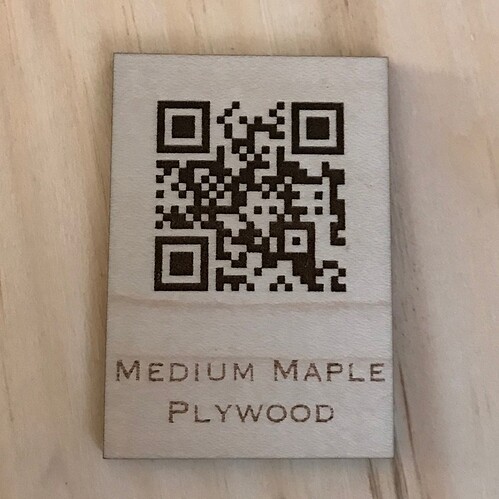ya this was my plan given how bad the focus issues have been . as well as once you need the section of material where the label is etc…
This has come up other places but bears repeating here.
Rare earth magnets are great for holding down light items that would blow about otherwise as well as pulling slight warp out of wood long enough to cut it.
As @mark said, you can do this, but it can be pretty annoying if when you have a partial piece of PG without the QR code. Every time you lift the lid to re-position/flip an item or load a new design, the ID will fail, forcing you to re-select the material again. I’ve been building a collection of printed QR codes to throw on the bed when using scraps – it’s a huge timesaver. ![]()
I hadn’t though about this but until we get invisible QR coding this means proof grade has a definite top and bottom?
Definite, no. Easier, yes. I’ve cut from both sides (in part to preserve the QR code for later) – it really doesn’t make difference.
That gave me an idea:
I read the QR code data as text using a scanning app (“Glowforge:B:AMAABzE”). I entered that into an online QR code generator to get a clean JPEG, and threw in a cut line and some text and cut it out of, appropriately enough, medium maple plywood. It works, and there shouldn’t be any issue with it flying off.
Two short tips I discovered while making this:
- All those tiny squares to weed! I learned that Gorilla tape is wonderful for that.
- Ever since I have been using my Glowforge, I noticed smoke odor coming from it, and thought oh well, that’s just residual odor and/or smoke coming back in through the window. Nope! Make sure your exhaust hose is well attached, mine had a gap at the bottom.
@jsc you can also click on the Unknown Material words at the top of the lefthand column, and it will give you a drop-down that will load any settings for the Proofgrade materials. There’s a search bar, just type in “maple” and it pulls up all the choices.
I know, and eventually with a lot of Proofgrade materials, a search in a drop down will be far easier than a physical search through a pile of QR code tokens. I’m just playing around so far, figuring out how stuff works.
Cool! Wasn’t sure you’d seen it yet. 
You don’t need to weed them. It works regardless. Also, a Cricut scraper or even a credit card edge will push the tape off the squares. Cheaper than Gorilla tape ![]()
This is a great idea!
Go one step further and create QR code for non PG materials settings (based on what you determined worked well) - will the GFUI read that and automatically invoke the settings? 
I wish. I bet the QR code data just encodes some material/batch data that is hardcoded somewhere.
It is unlikely that they invented a coding scheme to turn all of the cut settings into 7 alphanumerics. Especially since that would mean if they decided to add another engraving option, or otherwise tweak the settings, it would nullify all existing QR codes.
And anyhow, if your QR doesn’t match one of the options in the dropdown list, then it wouldn’t function anyhow (sadly).
I am looking forward to being able to save commentary on our designs which exist in the GFUI so that I can keep my settings digitally, and cross-platform.
Till then… anotepad.com works.
Have only had mine for ~12 hours, but when I manually selected the material (because it wouldn’t read the proof grade sticker, I later just moved the board and it scanned) I got warning after warning and didn’t see an obvious way to clear the warning.
You didn’t say which warning. If it is the warning that Proofgrade wasn’t detetected, then you get that anytime it doesn’t recognize the QR even if you select it manually. Kind of useless, but harmless in that you don’t have to clear it. Might be because they knew users would select Proofgrade settings with non-Proofgrade installed and the lawyers weren’t comfortable. No real idea.
Is that the warning you are talking about?
Does anyone know if I’d be able to cut through multiple layers of the same material (ex. 2 pieces of 1/8in. pine stacked on top of each other)? If so, I’m assuming the pieces should be glued or taped together in a spot where the laser wouldn’t pass through.
Any feedback on how to improve efficiency when cutting multiple copies?
Unfortunately, not a good idea.
You’re messing with fire, and an air gap in between the slats would feed it. Might cause overburn, or even let a fire get out of control.
(They used to have something in the Manual about being limited to just one thickness of material…not sure if it made it into the final version.)
This is a great answer, thank you! I won’t be taking chances. I’ll stick to cutting layered copies on my bandsaw 
Well now I’m going to have to try it.  ️ Seems like it shouldn’t be much different than plywood - e.g. multiple layers often with voids or pockets.
️ Seems like it shouldn’t be much different than plywood - e.g. multiple layers often with voids or pockets.
Although I wouldn’t do it in practice because I’d be getting bigger kerfs and potentially more char vs just running two or more at a time as single items on a sheet - not as fast but cleaner.
